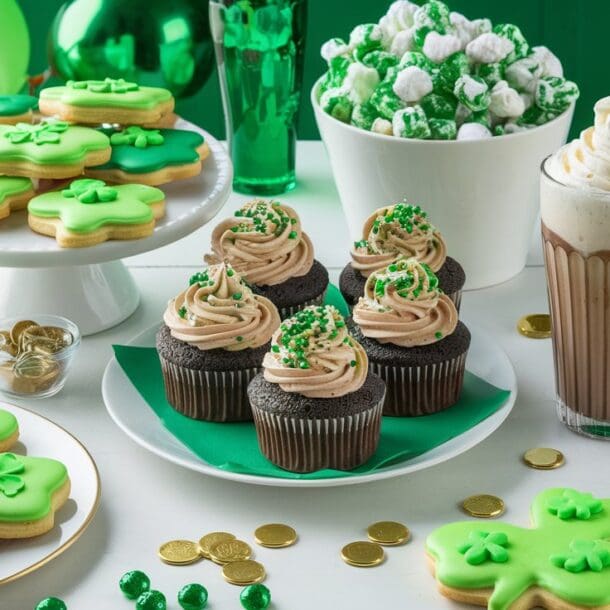
This website uses cookies to ensure you get the best experience on our website. View our Privacy Policy here.

Share this article via:
Please note: This website contains affiliate links. As an Amazon Associate, we earn from qualifying purchases at no additional cost to you.
.
Ready to turn your beer into the ultimate St. Patrick’s Day showstopper? With this quick and easy trick, you’ll be serving up festive vibes in less than five minutes. Green beer might not be an authentic Irish tradition, but here in the U.S., it’s basically a party staple. And let’s be honest – who can resist a bright green drink that screams, “Let’s celebrate”?
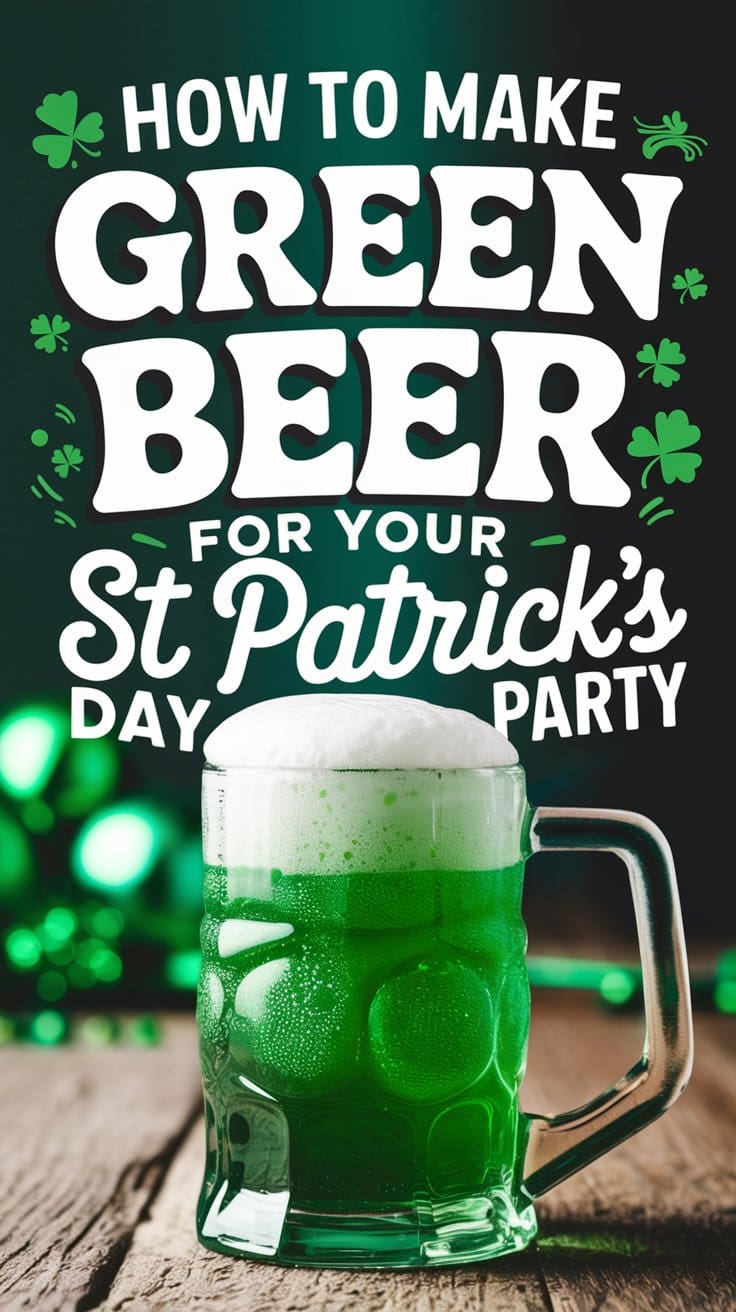
All you need is your favorite light beer (think Budweiser, Miller, or Coors) and a little green food coloring magic. The lighter the beer, the better the green – trust me, dark stouts and food coloring do not mix well. Bonus: this hack doesn’t mess with the taste, so your beer still tastes like beer – just with a festive twist.
Whether you’re gearing up for a St. Paddy’s bash, trying to impress friends at a campus event like Miami University’s famous Green Beer Day, or just want to make your Instagram feed pop, this recipe is a guaranteed hit. So grab a pint, a few drops of green food coloring, and get ready to wow your friends with your mixology (or just your knack for holiday fun). Cheers to being the life of the party – green beer in hand! 🍀🍻
Green beer is a key part of St. Patrick’s Day in American Irish culture. It started as a fun idea and grew into a national tradition. This tradition shows the playful side of the holiday.
Professor Thomas H. Curtin introduced green beer in 1914. He made it at the Schnerer Club in New York City’s Bronx. Before then, “green beer” meant young or bad beer that could upset your stomach.
By the 1950s, green beer was a big part of American celebrations. It quickly became popular, showing the strong Irish American connection to St. Patrick’s Day.
Miami University in Ohio made “Green Beer Day” a tradition. It’s held the Thursday before spring break. This shows how green beer is a big part of college life.
| Year | Green Beer Milestone |
|---|---|
| 1914 | First documented green beer creation |
| 1950s | Widespread adoption in St. Patrick’s Day celebrations |
| 1985 | International spread of green beer tradition |
Choosing the right beer for St. Patrick’s Day green beer is key. Not all beers turn green well.
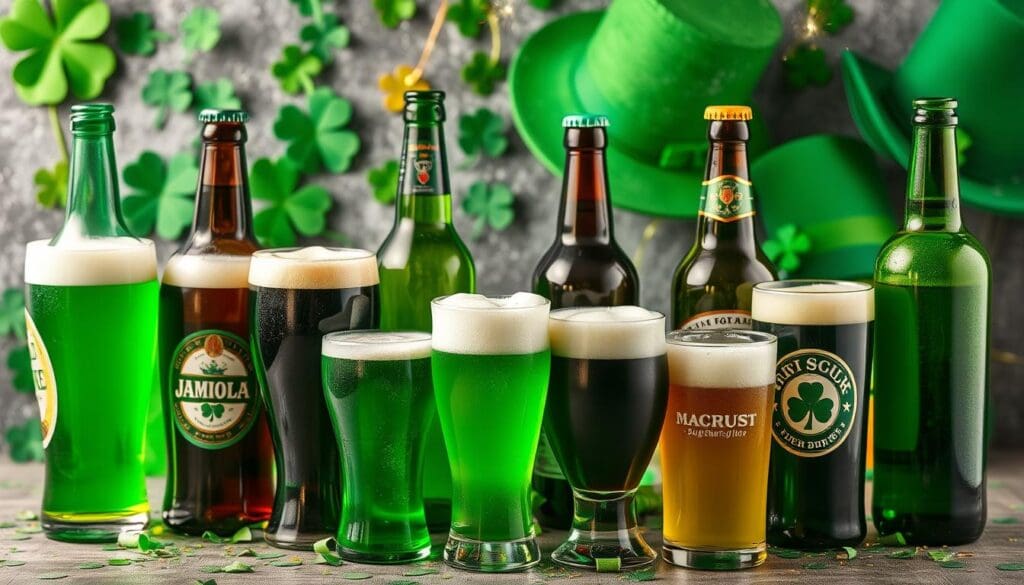
Beer lovers know the color and clarity matter a lot. Light beers work best because they’re clear.
A July 2022 Statista survey found lagers are the top beer in the U.S. They’re perfect for green beer. Cream ales and pilsners also make great green drinks:
Dark beers like stouts make green less vibrant. They turn green but it’s not as bright.
| Beer Type | Recommended Brands | Green Color Potential |
|---|---|---|
| Light Lager | Budweiser, Miller, Coors | Excellent |
| Pilsner | Harp, Stella Artois | Very Good |
| Wheat Beer | Blue Moon, Shock Top | Good |
Pro tip: Add 2-3 drops of green food coloring per glass. This makes the beer bright green without changing the taste. Lighter beers make greener beer!
Making green beer for St. Patrick’s Day is simple. It turns a regular beer into a fun, green drink. This is a key part of celebrating Irish culture.
To make your green beer, you’ll need a few things:
The key to great green beer is the right beer. Use light beers like Budweiser, Miller, or Coors for the best color. Dark beers, like Guinness, won’t show the green well.
Here’s how to make your green beer:
Tip: Use liquid food coloring for green beer. Gel or powder can change the beer’s feel. Start with a little color and add more if needed.
Follow these steps and you’ll be the hit of any St. Patrick’s Day party. Your green beer will be a big hit with your friends!
St. Patrick’s Day is all about creativity, especially with green beer. While many use traditional food coloring, there are new ways to make beer green.
For a classic green beer, you need food coloring. It’s important to add the right amount. Tests show different shades:
For a healthier green beer, try natural ingredients. They offer unique colors:
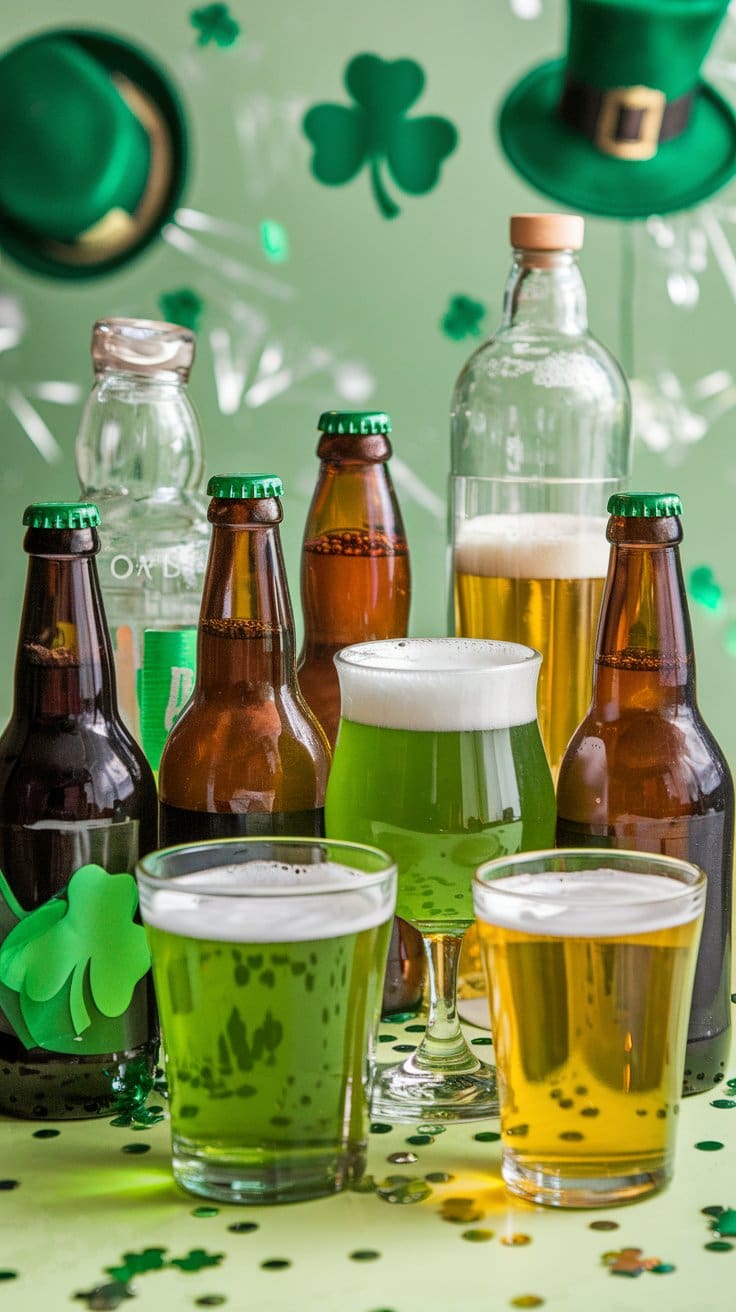
Beer lovers can try new ways to color their beer green. Ideas include using rock candy sticks, mixing blue curaçao with lemonade, or adding green Skittles.
Lighter beers like lagers and pilsners are best for a bright green. Darker beers can hide the color, making it harder to achieve.

Mastering the art of green beer presentation is key for any St. Patrick’s Day party. The right beer pouring techniques can turn an ordinary drink into a festive centerpiece. Let’s explore the secrets of creating the perfect green beer that will wow your guests.
Preparation is crucial for your green beer masterpiece. Before starting, make sure you have these essential tools:
The perfect green beer pour requires a precise method. This ensures both visual appeal and taste preservation. Here’s a step-by-step guide to achieving the perfect green beer presentation:
Understanding the science behind green beer can make your St. Patrick’s Day party even better. Different beers react differently to food coloring, so choose wisely!
| Beer Type | Color Result | Food Coloring Needed |
|---|---|---|
| Pilsner | Bright Green | 2-3 drops |
| Pale Ale | Light Green | 2-3 drops |
| Dark Beer | Deep Green | 4-5 drops |
Pro tip: Serve immediately after pouring to keep the vibrant green color. Your guests will be amazed by your beer pouring skills and attention to detail!
Making the perfect green beer for St. Patrick’s Day can be tricky. You need to pay close attention to detail. This ensures your drink looks great and tastes even better. Let’s look at the most common mistakes that can ruin your St. Patrick’s Day celebration.
When using food coloring, remember: less is more. Too much color can lead to unexpected results:
The temperature of your beer is key to the perfect green color. Warm beer can cause too much foam and uneven coloring. Keep your beer cold and pour it gently to keep the carbonation and color even.
| Beer Type | Recommended Temp | Coloring Difficulty |
|---|---|---|
| Light Lager | 38-40°F | Easy |
| Dark Ale | 45-50°F | Moderate |
| Stout | 50-55°F | Challenging |
Proper mixing is crucial to avoid mistakes. Stir gently to avoid too much foam and ensure even color. Avoid stirring too hard, as it can make your drink messy and foamy.
By following these tips, you’ll make a festive and delicious green beer. It will impress your friends and keep the celebration spirit alive!
Homemade green beer is a fun part of St. Patrick’s Day in the U.S. It started as a quirky tradition in 1914. Now, it’s a festive ritual that adds fun to home parties.
It’s not just about changing the color of your drink. It’s about embracing Irish-American traditions with a playful twist.
Some might say green beer isn’t true Irish culture. But it shows the joy and adaptation of American holiday celebrations. You can use Coors Light, Bud Light, or a crisp pilsner to find your favorite green brew.
Start with a few drops of food coloring to get that bright green color. Adjust as needed.
As St. Patrick’s Day nears, get creative with your party. Add Irish decorations, play traditional music, and play games. Green beer is just one fun part of the celebration.
If you prefer something more traditional, try a Guinness or Irish whiskey. But homemade green beer is all about the fun and memories it creates.
The real magic of homemade green beer is the laughter and togetherness it brings. Cheers to making unforgettable memories and keeping this American tradition alive!
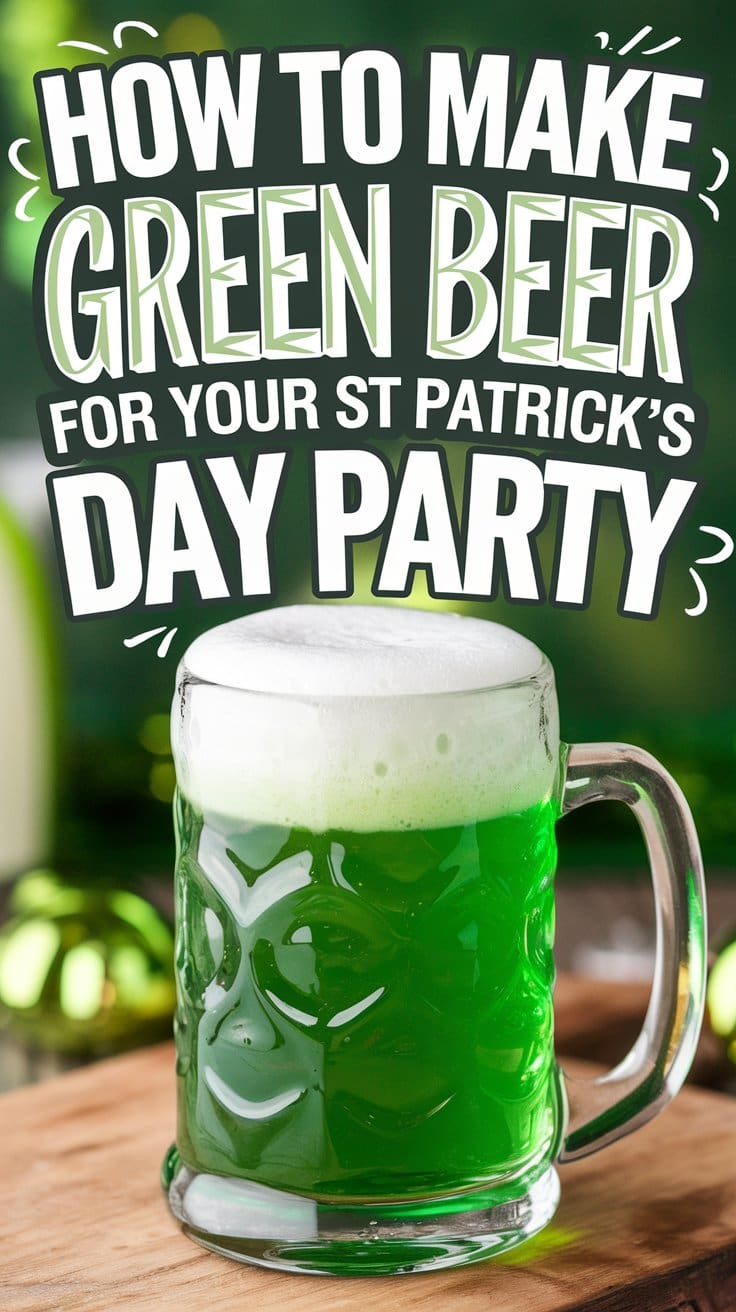
Green beer is a festive drink made by adding green food coloring to light-colored beer. It’s especially popular during St. Patrick’s Day in the United States. It’s a fun way to add holiday cheer to your drink.
Dr. Thomas Curtin, a doctor and eye surgeon, first made green beer in 1914. He did it for a St. Patrick’s Day party at the Schnerer Club in the Bronx, New York.
Light-colored beers are best, like American lagers like Budweiser or Miller. Craft beers, German pilsners, and Irish pale ales like Harp also work well for vibrant green beer.
To make green beer, add 1-2 drops of green food coloring to a glass. Then, pour 12 ounces of light beer into the glass slowly. Stir gently if needed. You can add more coloring if you want a deeper green.
Yes! You can use a green rock candy stick to stir the beer. Or add matcha green tea powder, green Skittles, or wheatgrass powder. Each method gives a different shade of green and might change the taste a bit.
You can use dark beers like stouts, but they’ll make a darker, evergreen-colored beer. You might need more food coloring. But be careful not to add too much.
No, green beer isn’t an authentic Irish tradition. It’s an American invention that’s become a big part of St. Patrick’s Day in the United States.
Use a chilled glass and add food coloring first. Pour the beer slowly at an angle to avoid foam. Serve it right away. Don’t use too much food coloring, as it can stain teeth and change the taste.
Green beer became popular in 1952. Miami University in Ohio started “Green Beer Day” then. It’s celebrated annually on the Thursday before spring break, with bars opening early.
Don’t use too much food coloring, as it can stain teeth and change the taste. Keep the beer cold to keep the carbonation. Mix gently to avoid too much foam.
Please note: This website contains affiliate links. As an Amazon Associate, we earn from qualifying purchases at no additional cost to you.
.
Share this article via:

This website uses cookies to ensure you get the best experience on our website. View our Privacy Policy here.